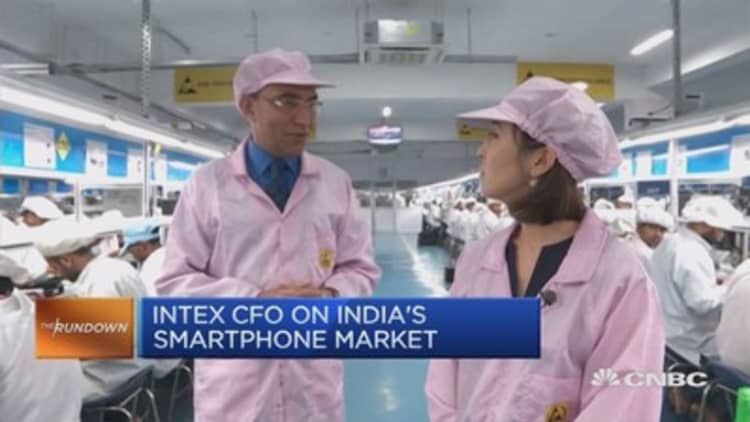
This article is part of a "Reporter's Notebook" series, wherein CNBC journalists submit tales and observations from the field.
NOIDA, India — The Intex brand doesn't have much name recognition beyond India's borders. In fact, the Indian smartphone maker has even struggled to compete in its home market — pushed aside by global players like Samsung and Chinese tech giants.
Yet, the Intex factory in Noida, an hour outside of Delhi, offers a glimpse into the playbook of Indian companies and their aggressive push to "Make in India," an initiative Prime Minister Narendra Modi launched three years ago to encourage local manufacturing and spur job creation.
The facility located in this industrial neighborhood is just two years old. And with 750 people working directly on the assembly line, the operation pales in comparison to compounds established by manufacturing giant Foxconn, which employs hundreds of thousands of workers that assemble Apple's iPhones in China.
Intex workers pull 8.5-hour shifts every day. Each wears a white lab coat and chef-like hat. Each repeats the same tasks in robotic fashion — sorting through components at the front of the assembly line, packaging the final product at the end of the line. The phones are dropped, scratched and squeezed daily to ensure quality control.
The factory churns out 15,000 smartphones and 10,000 feature phones a day. But Intex CFO Rajeev Jain has his eye on another figure: The 70-30 ratio of imported-to-domestic components.
"We are focused on reducing the imported content," Jain said. "By 2019, most of the components are going to be domestic only. This percentage should definitely reverse."
Jain says that reversal is key to Intex lowering the cost of its handsets — and ultimately competing with foreign players at home. While the company has five factories throughout India, just one is dedicated to developing components. It's in the process of building a sixth plant, to reduce its imports from 70 to 20 percent in the next two years.
That effort to sell cheaper, locally produced smartphones has taken on increased importance since November last year, when the government pulled more than 80 percent of banknotes from circulation in an effort to tackle black money. That forced millions of unbanked users onto smartphones to utilize digital payments platforms like Paytm.
Yet internet penetration remains just over 30 percent in a country with an estimated population of over a billion. While the government has challenged local handset makers to develop low-cost smartphones that make digital transactions accessible to the masses, Jain said larger infrastructure issues have proven to be a large hurdle.
"Eighty percent of India resides in villages and tier-two, tier-three cities," Jain said. "Before, the availability of electricity was a very big issue. Then, networking was the biggest issue. The comfort of the people to user the mobile phone was an issue because of lower education."
Demonetization has accelerated that digital literacy, and the government has implemented a 10 percent import duty to help local companies like Intex get ahead.
Still, Jain admits domestic companies still lag far behind their Chinese competitors who have spent years building out their own ecosystems in India. Not one local player cracked the top 5 in sales, in the first quarter.
"Whatever positive things they are building, we should take lessons from there," Jain says, referring to his company's counterparts in Asia. "We have our own grassroots way of doing business. With those lessons in place we will succeed in the future."


